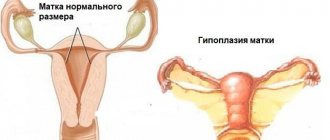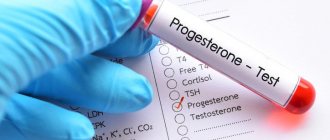At the turn of 40-45 years, large-scale changes begin in the female body associated with the decline of reproductive function. Over the course of several decades, along with the endocrine system, it produced a number of hormones necessary for the balanced functioning of all systems.
A decrease in the intensity of the reproductive system is accompanied by hormonal imbalance, when the values of FSH and LH sharply increase or decrease during menopause, the production of estrogen decreases, and the level of progesterone decreases, causing ailments and exacerbations of chronic diseases. For personal peace of mind, it is worth understanding the concept of the norm for this period and knowing what to expect next from a total change in the body called menopause.
hide FSH indicators during menopause Methods for normalizing the hormone Estradiol levels during menopause Determination of hormone levels during menopause Estradiol levels during surgical menopause Methods for bringing estradiol levels back to normal
FSH indicators during menopause
Norms often fluctuate and depend on many reasons.
The main cause is the depletion of the ovaries and the disappearance of the follicles in them. During reproductive age, the amount of the hormone is regulated by releases of the substance at regular intervals, which ensures its stable level. From the moment of premenopause, the norm changes up or down, causing hormonal disturbances. Progesterone production decreases, the uterine lining stops renewing itself, and the monthly cycle is disrupted. Estradiol also changes levels during menopause. From the moment menstruation ceases and the reproductive system stops functioning, the FSH rate changes, since its main function, which is to regulate the formation and functioning of the reproductive system, is lost. The hormone is responsible for the ripening and preparation of the follicle for fertilization. When estrogen production decreases, an interrelated reaction occurs; the body releases an increased amount of FSH to stimulate an organ that, in fact, no longer works. As a result, a significant part of unclaimed hormones is formed, disturbing the already fragile balance.
The norm depends on many factors, with age playing an important role:
- up to 9-10 years the indicator is 1.5-4 mIU/l;
- in adolescents, the level increases very quickly, reaching an adult value of 5.9-25 mIU/l;
- the peak occurs at the time of ovulation, decreasing slightly at the end of the cycle;
- a sharp jump at the beginning of menopause brings the data to 30 to 40 mIU/l;
- the indicator increases several times with full menopause, when menstruation has stopped completely and reaches 135 mIU/l;
- menopausal changes do not end there, and after a few years, depending on the individual characteristics of the body, the level drops to 18-54.9 mIU/l.
Increased levels of follicle-stimulating hormone are observed when taking medications to stabilize sugar levels, antifungals, and statins. Increases the rate of addiction to bad habits, unbalanced diet, adherence to mono-diets, stress, infectious diseases, endometriosis, ovarian tumors.
It is recommended to take an FSH test when persistent signs of the onset of menopause appear. A high level confirms the onset of age-related changes; a low level warns of the possible development of a number of diseases.
Determination of hormone levels during menopause
This indicator is very important for preventing the development of diseases during menopause. Based on its level, you can judge the current period of menopause, take preventive measures or undergo a narrowly focused examination if there is a threat of developing oncology, endometriosis or breast cancer.
Special tests are prescribed, based on blood from a vein. The menopause test gives only general indicators, indicating a stop in the reproductive system. Only a laboratory test for hormones will provide more detailed data.
Reasons why a woman has elevated estradiol
The use of a one-time hormone test to make a diagnosis is not correct, since its level varies during the menstrual cycle. The peculiarity of deciphering the results is that the doctor needs to monitor the content of the hormone in the blood at different phases of the menstrual cycle. If deviations are detected, repeated studies are carried out to assess the dynamics of estradiol levels.
Any deviation of estradiol from the norm is not a specific sign of a certain pathology. In this regard, the analysis is carried out in conjunction with other studies (ultrasound of the ovaries, comprehensive examination of the hormonal profile, etc.).
Increased estradiol in women is referred to as hyperestrogenism. The reasons can be divided into:
- primary, when secretion increases against the background of ovarian pathologies;
- secondary, not associated with hyperfunction of the ovaries or adrenal glands.
Primary causes
Hormone-synthesizing neoplasms of the ovaries are classified as primary. Some tumors are capable of synthesizing hormone-like substances similar to estradiol. Therefore, the patient’s test results reveal an increased value.
A similar situation is observed during the formation of an adrenal tumor.
Another reason for high estradiol levels in women is chorionepithelioma, a malignant tumor that grows in the form of a node in the upper part of the uterus. Such a formation is capable of synthesizing female sex hormones in excess quantities.
It is also possible to develop hyperestrogenism due to the persistence of follicles or the presence of endometrioid cysts.
Secondary causes of increased estradiol
Secondary causes include:
- incorrectly selected oral contraceptives, which led to hormonal imbalance;
- treatment with anabolic steroid drugs;
- treatment with carbamazepine, cimetidine, clomiphene, ketoconazole, mifepristone, nafarelin, etc.;
- presence of excess body weight. It is known that fat cells actively produce female sex hormones;
- hepatitis of viral etiology or cirrhosis of the liver. These pathologies contribute to cell destruction. What causes disruptions in the process of hormone metabolism. Against the background of insufficient removal of estradiol from the body, its value in the analysis results increases.
In girls, an increase in estradiol levels indicates the onset of puberty and the approach of menarche.
ROOM
RESULTS ROOM ROOM RESULTS ºÐ°Ðº Ñаки ROOM лÑном диÑбаланÑе, поÑвлении ÑндомеÑÑиоР·Ð°, поликиÑÑоза, поÑеÑной недоÑÑаÑоÑноÑÑи. RESULTS ¸ ROOM ², ROOM RESULTS ²Ð °Ð½Ð¸ÐµÐ¼ киÑÑÑÑ.
ROCK ROOM °ÑÑÑплении Ñанней менопаÑÐ ·Ñ, иÑÑоÑении ÑиÑников и беÑплодии. RESULTS RESULTS ¸Ð°Ð³Ð½Ð¾ÑÑи RESEARCH ¸ÐµÐ¼ беÑеменноÑÑи, оÑобенно пеÑед п RESULTS. ››› ASSESSMENT °ÐºÐ°Ð¼Ð¸, но Ñакие ÑезÑлÑÑаÑÑ ÑÑебÑÑÑ Ð¿Ð¾Ð²ÑоÑной Ñ RESULTS, CONDITIONS OPEN ROOM › RESULTS анизма женÑинÑ.
RESEARCH, RESEARCH, RESEARCH RESULTS SMALLERY registry Ñ, назнаÑил дополниÑелÑнÑе меÑÐ¾Ð´Ñ Ð¸ÑледР¾Ð²Ð°Ð½Ð¸Ñ и пÑи необÑодимоÑÑÐ ¸ леÑебнÑе меÑопÑиÑÑиÑ.
Why is the FSH hormone low?
A low hormone level may indicate secondary changes in the male body.
FSH may be reduced due to:
- disruption of the endocrine system;
- Klinefelter's syndrome;
- Shereshevsky-Turner syndrome;
- consequences of injuries, operations and tumors on the pituitary gland;
- tumors of the brain, adrenal glands, testicles;
- poor absorption of nutrients in the intestines;
- chronic pancreatic diseases;
- diabetes mellitus;
- long-term use of hormonal drugs, especially hormones and anticonvulsants;
- if androgen levels are reduced due to old age;
- FSH may also be reduced as a result of testicular tumors with increased secretion of androgens;
- low levels of the hormone are observed in people with a tendency towards anorexia, although this is more true for girls;
- The hormone also decreases in obesity;
- with regular alcohol intoxication;
- in case of heavy metal poisoning;
- with regular stress, depression;
- Also, low FSH levels are normal for dwarfism.
A decrease in hormone levels can cause sexual problems, impotence, testicular atrophy, and a decrease in the number of viable sperm.
It is impossible to increase indicators using folk remedies; the norm can only be achieved through complex treatment using hormonal drugs and eliminating the very cause of the failure.
Symptoms that require an FSH test:
- male infertility;
- suspected pathology of the pituitary gland;
- rapid or, conversely, delayed puberty in boys;
- gynecomastia – enlargement and swelling of the mammary glands in men;
- hypoplasia is a disease characterized by a decrease in the size of one or two testicles;
- female pattern hair growth;
- formation of female-type fat deposits (on the chest, hips);
- suppression of libido;
- memory impairment and decreased attention;
- general feeling of weakness, pain in the heart area.
When is it necessary to donate blood for FSH?
The FSH norm in women differs by age. There is a special table that can be used to determine the normal result at a certain period of life. A test to determine the level of follicle-stimulating hormone in the blood should be taken when identifying various gynecological diseases, especially in female infertility.
If the doctor notes that gonadotropins are elevated and the amount of sex steroids is much lower, this means decreased activity of the gonads. In addition, venous blood is taken for analysis to determine the effectiveness of therapy, to identify menopause, and also to correctly select oral contraceptives.
If the patient is concerned about the following reasons, then she is referred for a test:
- non-pregnancy with regular sexual activity;
- there is no ovulation;
- untimely puberty (earlier or later);
- vaginal bleeding resulting from unscheduled functioning of the organ;
- growth of the mucous uterine layer;
- chronic inflammation of the internal genital organs;
- prolonged menstruation or its complete absence;
- in case of testing the effect of hormonal drugs on the body.
Other reasons for decreased FSH
As previously mentioned, everything, even the smallest organs of the body, are interconnected and interdependent on each other, and changes in one of them negatively affects many:
- FSH levels decrease when pregnancy occurs. The level of follitropin in pregnant women remains low until the birth of the child and throughout the postpartum replacement period;
- ovarian pathologies such as tumors and cysts;
- disturbances in the activity of the hypothalamus and pituitary gland;
- excess prolactin-like protein.
It must be said that all these diseases are not common in women, and there is no need to panic in advance if you discover a problem with the FSH hormone. To eliminate the danger of these diseases, the doctor usually prescribes an ultrasound of the pelvic organs and laboratory blood tests for hormone levels.
LH level during menopause: how does it change?
During the onset of menopause, the resistance of the ovaries to substances affecting them increases. Ovarian tissue is no longer able to produce the required amount of estrogen.
In response to a decrease in estrogen, the anterior lobe of the pituitary gland begins to intensively produce LH. However, due to the resulting resistance, it is not used as before, and its amount in the blood increases.
LH analysis during menopause: when is it needed?
Testing for the amount of gonadotropic hormones (LH and FSH) should be carried out at the first symptoms of menopause. They are:
- increased intervals between menstruation and shortened bleeding;
- weakness and dizziness;
- the appearance of insomnia;
- irritability and tearfulness;
- flushes of heat to the face;
- increased heart rate, etc.
This is necessary in order to determine whether these symptoms are the onset of menopause, or whether they are manifestations of any disease.
An analysis for determining luteonizing hormone is carried out on days 3-8 or 21-23 of the menstrual cycle, when its complete physiological decrease occurs after ovulation. To prepare for the delivery procedure you must:
- For three days before donating blood, limit the consumption of fried and fatty foods and alcoholic beverages.
- Avoid heavy physical activity the day before the test.
- Avoid smoking 12 hours before the procedure.
- Do not eat three hours before the test. You can only drink clean water.
LH norm in women during menopause
Since the amount of gonadotropic hormones increases during the menopause, the norm of the LH hormone during menopause is 14.09 – 51.9 mIU/ml.
Not only the amount of luteonizing hormone is important, but also its ratio to FSH. If during the reproductive period their normal ratio was at the level of FSH:LH = 1:1.5-2, then in the postmenopausal period it changes to 1:0.5-0.9. This is due to a more significant increase in follicle-stimulating hormone compared to LH.
Deviation of LH from normal values
An increase or decrease in normal LH values during menopause may indicate the development of pathology of the reproductive system.
An increase in lutropin is typical for the following diseases:
- pituitary adenomas;
- endometriosis;
- PCOS (polycystic ovary syndrome);
- serious pathologies of the urinary system;
- taking the following medications (tamoxifen, ketoconazole, prednisolone, metformin, dexamethasone, goserelin, etc.)
Important! When taking tests, you must warn your doctor about taking all medications, as some of them can significantly affect the results. A decrease in lutropin is observed when:
A decrease in lutropin is observed when:
- pituitary insufficiency;
- gonadotropic hypogonadism;
- genetic diseases (Sheehan syndrome);
- Symonds' disease;
- taking the following medications: (carbamazepine, dopamine, digoxin, progesterone, valproic acid, combined oral contraceptives).
LH is elevated during menopause, and FSH is normal
An increase in luteonizing hormone against the background of normal FSH values is a possible sign of the disease and requires additional diagnostic measures. However, before this, it is recommended to retest LH and FSH in the next menstrual cycle on days 5-7. This is necessary to confirm the results and eliminate errors in the study.
Since the most likely cause of this condition is an adenoma (benign tumor) of the anterior pituitary gland, the following diagnostics are used to detect it:
- X-ray of the skull with a projection of the sella turcica;
- CT head;
- MRI of the head;
- blood test for other pituitary hormones (prolactin, somatostatin, melatonin-producing hormone).
The value of luteonizing hormone is an important indicator of the functioning of the reproductive system. To monitor the course of the menopausal period, it is necessary to study LH in dynamics. This will help prevent the development of complications of menopause. When menopause occurs, its amount in the blood increases, which is a completely normal phenomenon.
Anastasia Vinarskaya, obstetrician-gynecologist, especially for Mirmam.pro
Ratio of LH and FSH
Before puberty, the ratio of LH and FSH is 1:1; when a teenage girl begins menstruation, it changes and is 1.5:1. During the stabilization of the menstrual cycle, the hormone ratio becomes 2:1. If the LH concentration is even higher and reaches 2.5, then this may indicate ovarian tumors, cysts, or polycystic ovary syndrome.
The concentration and ratio of FSH and LH during menopause and pregnancy also change. Thus, during pregnancy there is a decrease in the production of these hormones, since their production is regulated in several ways, and one of them is an increase in estrogen and progesterone in the blood. Throughout pregnancy, they are produced less than usual; the same condition is observed during breastfeeding, when elevated prolactin inhibits ovulation and the development of the corpus luteum.
The ratio of LH and FSH during menopause also changes. This is due to the aging of ovarian tissue, a decrease in primary follicles in them. With each cycle, the amount of FSH in the blood increases as the ovaries' production of estrogen and progesterone decreases. LH also rises, but much more slowly. The level of FSH in the blood, if determined monthly, can predict the approach of menopause in a woman.
A gradual increase in FSH leads to the fact that the ratio of LH and FSH during menopause becomes less than 1, since the concentration of follicle-stimulating hormone increases several times. Knowing about changes in FSH and LH during menopause, it is possible to predict the development of early menopause in a woman and promptly begin treatment, carry out replacement therapy, which will delay menopause and reduce unpleasant symptoms during it.
Age-related changes in FSH and LH
Determining FSH and LH is important for women over 35 who, with infertility, want to take advantage of the possibilities of assisted reproductive technologies and undergo IVF. The approach of menopause indicates that the ovarian reserve of the ovaries is reduced, and in such a situation, fewer eggs can be obtained during stimulation. Age-related changes also affect the quality of eggs, that is, problems with fertilization may arise, genetic pathologies may be detected, and the percentage of embryo implantation in women over 35 years of age is much lower.
Therefore, taking into account the level of increase in FSH, as well as the AMH content, a woman may be offered to use donor eggs, since studies show that implanted embryos obtained as a result of fertilization of a young woman’s donor egg are implanted 2-2.5 times more often.
Disturbances in the concentration of hormones in the blood can be corrected using hormonal therapy. For it, both hormonal preparations are used, which include natural hormones, and those obtained by genetic engineering methods, synthetically.
source
Changes in FSH depending on the phase of the menstrual cycle
An increase in FSH occurs with age and with the start of menstruation.
From the beginning of menstruation until the maturation of the egg, the level increases steadily, during ovulation it reaches its peak, and after that it gradually decreases, and by the beginning of menstruation it drops to its lowest level.
Menstrual phase from 1 to 6 days
From the 1st day of the monthly cycle, the growth and development of follicles is observed, which is why the level of follitropin gradually increases. Normal values during this period are from 3.5 to 12.5 mIU/ml.
Follicular phase from days 3 to 14
With the development of the follicular phase (3-14 days), the concentration of FSH constantly increases. In order to see the difference in changes in the indicator (increase), you should take tests over time after 2-3 days. It should be taken into account that the hormone enters the blood unevenly, but in impulses every 1-4 hours, the synthesis process takes about 15 minutes.
Normafollicle-stimulating hormone varies depending on the phase of the menstrual cycle
The normal value in the follicular phase remains the same from 3.5 to 12.5 mIU/ml.
Ovulatory phase from 13 to 15 days
The peak value of follitropin is reached during the ovulatory period after the passage of which its concentration gradually decreases. The phenomenon is explained by the fact that during the ovulation phase the egg matures and is subsequently released from the appendages. The follicle, which has reached its maximum size (largest) at the time of ovulation, ruptures, forming the “corpus luteum.”
The FSH value during this period can fluctuate between 4.7-21.5 mIU/ml.
Luteal phase from 15 days before the start of menstruation
Follicle-stimulating hormone, the norm in women in the luteal phase of which reaches its minimum value, begins to fade under the influence of increased production of biologically active substances by the “corpus luteum”, formed from the burst follicle. So if fertilization has occurred, then the uterus is preparing for pregnancy, and if not, then the menstrual cycle ends.
Normal values for FSH during this period are considered to be from 1.7 to 7.7 mIU/ml.
Normal hormone ratio for conception
LH and FSH change their ratio throughout the entire monthly cycle. Immediately after the end of menstruation, the follicular phase begins. This period is characterized by a predominance of the substance responsible for stimulating the activity of the gonads. Until days 6-9 of the cycle, there is an increased concentration of follitropin and a decreased level of luteinizing hormone. When ovulation completes, the luteal phase begins. At this time, on the contrary, the amount of FSH declines, and LH rises.
The graph shows how LH and FSH increase when the egg leaves the follicle at the end of the follicular phase. The normal ratio of these hormones to each other is shown to the right of the graph.
Before reaching adolescence, the production of these hormones occurs in the same amount, therefore, their ratio is equal to one. After the appearance of the first menstruation, the level of luteotropin and follitropin gradually increases. After one year, the coefficient corresponds to 1.5, and after another year - 2.
If the reproductive system is functioning normally, then the ratio of luteinizing and follicle-stimulating hormones should be up to 2.5 .
The gonads function correctly with the optimal ratio of these substances. When abnormalities are detected, in particular when the production of these hormones increases, it is very important to promptly take appropriate measures to reduce the concentration. Methods for solving the problem depend on the factors that caused the violations.
What hormones does it affect?
Estradiol not only helps a woman look attractive, but also stimulates the production of a number of other hormones: corticotropin, aldosterone, somatropin and oxytocin
When diagnosing female diseases, you need to pay attention to the indicators and interaction of estrogens with testosterone, progesterone and prolactin
What hormones are affected by:
- Testosterone. The ratio of male to female hormones should be 1 to 7-10. If this indicator is lower, then the woman has symptoms of hormonal imbalance.
- Progesterone. These are the two main hormones that help during pregnancy and lactation. Their indicators fluctuate depending on the phase of the cycle. During menopause, progesterone may decrease due to inflammatory diseases. When estradiol is low, progesterone levels rise.
- LH (luteinizing hormone) and FSH (follicle stimulating hormone). These hormones themselves influence estradiol more than it influences them. They participate in the synthesis and secretion of female hormones and help the formation of follicle maturation. LH acts on the membrane cells, stimulating the production of androgens, FSH acts on granule cells to ensure the conversion of androgens into estrogens.
Functions of FSH in the female body and the consequences of low FSH
Follicle-stimulating hormone is produced by cells of the anterior pituitary gland. Despite the fact that this particular gland is considered to be the king of the endocrine system, its secretion is completely controlled by the hypothalamus, or rather by its statins and releasing hormones. In this case, the release of gonadotropin-releasing hormone causes the synthesis of FSH and the development of its effects.
The point of application of follicle-stimulating hormone in the female body is the ovarian follicles. Follicles are a collection of epithelial cells surrounded by connective tissue fibers.
https://www.youtube.com/watch?v=A6KYH3vTNrE
In the center of this conglomerate there is a first-order oocyte - a cell that, as a result of maturation, is transformed into an egg. This process and the synthesis of female sex hormones, as well as the conversion of androgens into estrogens, are possible due to healthy levels of FSH.
In the male body, the target for follicle-stimulating hormone is Sertoli cells. They are located in the testicles, where they play the role of a barrier, protect and mechanically support gametes, which during the process of synthesis and excretion pass through the convoluted tubules.
For patients wishing to conceive a child using IVF, the value of this indicator is first determined. Taking this into account, a treatment and ovarian stimulation regimen is being developed.
This hormone is produced not only in the female body. FSH can tell a lot about a man's reproductive health. Its concentration affects the quality characteristics of male semen. Without follitropin, the concentration of testosterone decreases, which negatively affects the process of spermatogenesis.
The female reproductive system is subject to changes throughout the day, month and throughout life. Therefore, significant changes in the level of follicle-stimulating hormone are observed throughout the menstrual cycle and at different periods of development. Initially, after birth, high FSH levels are recorded, but after 1-2 years a decrease is observed.
A surge in concentration is recorded shortly before puberty, since the hormone is necessary for the normal development of the genital organs and the formation of secondary sexual characteristics. With the onset of the menstrual cycle, FSH levels begin to undergo serious fluctuations throughout the entire period.
Approximately in the middle of the cycle, the maximum value of this hormone is observed, at the same time there is a significant increase in the level of LH, which causes rupture of the dominant follicle and the release of a formed egg - ovulation and the ovulatory phase begin. A decrease in FSH during this period leads to anovulation and the formation of cysts in the ovarian area.
Then the luteal phase begins, during this period a decrease in FSH and an increase in LH levels are recorded, which is necessary to maintain the activity of the corpus luteum, formed at the site of the burst follicle, and the synthesis of progesterone, which helps create optimal conditions for pregnancy.
If fertilization does not occur or the embryo is unable to establish itself in the endometrium, the egg and embryo are rejected along with menstrual flow, the level of FSH gradually increases, which provokes the maturation of a new follicle, and the cycle repeats again. Low FSH during this period excludes the development of follicles.
LH norms
At the onset of menopause, the level of luteotropin will be quite high and not during the period of ovulation. For example, during menopause the indicator ranges from 30 to 60 units, while the norm for a woman of reproductive age is 12 units. It is this increase in luteotropin that can be considered the first signal of the onset of menopause.
Women who are going to take a hormone test to determine the fact of menopause should remember that luteotropin levels may be elevated due to taking the following drugs: Bromocriptine, Ketoconazole, Naloxone, Nilutamide, Tamoxifen, Finasteride, Mestranol and other drugs. Therefore, before taking the test, it is necessary to obtain clear instructions from your doctor on taking these medications. They are usually canceled a few days before blood sampling.
Not only a high level of luteinizing hormone can be erroneous, but also a suspiciously low one. A decrease in luteotropin levels can be affected by medications such as anabolic steroid drugs, Cyproterone, Octerotide, Phenytoin, Pravastatin, Norethindrone, Thioridazine and others. Taking these medications also needs to be taken seriously if you are going to have a blood test.
Useful video
From the video you will learn about the effect of hormones on menopause:
Menopause (or menopause) is a period in a woman’s life during which the reproductive function of the reproductive system stops and menstruation stops. This is a completely natural process that not a single representative of the fair sex has avoided when approaching a certain milestone in her years. This time comes at the age of 45 – 55 years, when the balance of hormones in the body changes. Hormones such as estrogen, progesterone, luteinizing hormone and FSH take part in the reproductive function of the body; the norm in women during menopause changes its values for each of these substances. Their purpose and quantity are of great importance for health and a fulfilling life.
Key Aspects
Analysis for menopause
For several decades and until our time, all pathological processes in a woman’s body have been associated with the onset of menopause. Manifestations of irritability, sudden mood swings, excessive sweating, urinary incontinence, and other symptoms were considered evidence of hormonal changes during menopause. They were practically not treated and therefore doctors recommended their patients to just wait and be patient.
Today everything is simpler, because after conducting several tests you can be convinced that pathological symptoms and sensations indicate the onset of menopause. With the help of tests, you can find out the nature of the changes and determine the need to correct them by taking hormonal drugs. After all, quite often it is sufficient to take vitamins and medicinal herbs in the form of decoctions and infusions.
Approximately three years before the complete disappearance of menstruation, premenopause begins to form; its duration is twelve months after the last menstruation. It is then that we can say that menopause has arrived.
On average, this occurs between the ages of 45 and 55, but cases of menopause occurring at an earlier or later age are no exception.
During this period, women are recommended to undergo a comprehensive medical examination (especially by doctors such as an endocrinologist and gynecologist), because hormonal changes occur in the body, which can cause the formation of pathological symptoms and processes.
What does an incorrect ratio mean?
To establish the ratio of follitropin and LH, luteotropin indicators are divided by FSH. The results obtained should fall within the range between 1 and 2.5. An increased coefficient always indicates the presence of pathological processes in the reproductive system.
Common causes of imbalance:
- The onset of early menopause.
- Benign tumors.
- Lack of follicles in the ovaries.
- Androgen resistance syndrome.
- Cysts on the ovaries.
It is important to understand that test results are greatly influenced by the patient’s mood, taking any medications, physical stress, etc. Therefore, you need to approach the preparation for testing responsibly.
Low values usually indicate the absence of ovulatory processes. If an increased coefficient is observed after the onset of menopause, then this is the norm.
Treatment
To begin treatment, it is necessary to establish the exact cause of the disturbance in FSH levels, so that the therapy is etiological, that is, it affects the cause and does not mask the symptoms of a serious disease. The drugs are prescribed by an obstetrician-gynecologist or endocrinologist.
How to lower FSH?
When FSH levels decrease, two main treatment regimens are followed. The first treatment regimen uses drugs that affect ovarian function: Phenytoin, Danazol. Based on the feedback principle, the pituitary gland reduces FSH production. After discontinuation of the drug, ovarian function is monitored by regular testing.
According to the second scheme, the functioning of the ovaries is maintained at the proper level, and the concentration of FSH decreases separately. The drugs of choice are Ovariamin, Vasalamin. Treatment lasts from several months to a year.
How to increase FSH?
When this is not enough, hormone replacement therapy is prescribed, but then the body’s ability to independently synthesize the necessary substances is lost due to uselessness.
Duphaston, Pregnil, Menogon help return the hormone level to normal and restore the ovulatory process. It is recommended to begin the use of pharmacological drugs strictly as prescribed by a specialist after carefully collecting anamnesis, laboratory diagnostics and taking into account all side effects.
An important diagnostic criterion - an increase in FSH indicates invisible problems in the body at any age. The period of the follicular phase is of particular importance for women of reproductive age: it indicates the ability to conceive and bear a child
It is important to consider this role for the male body as well.
Hormone analysis
Hormone analysis
In order to find out the reason for the disappearance of menstruation, it is necessary to take hormone tests during menopause. This need is explained by the fact that before the age of 50, the female body ceases to produce the required amount of hormones, which are responsible for the normal course of the menstrual cycle.
A study to determine the amount of hormones in the blood during menopause is carried out to determine the relationship between the absence of the menstrual cycle and the cessation of ovarian function. During menopause, some substances differ in their quantitative composition and one-to-one ratio.
It is thanks to the results of the tests performed that the attending physician has the opportunity to prescribe replacement treatment with hormonal drugs that will eliminate pathological and uncomfortable symptoms in women during menopause:
- tides;
- dryness of the vaginal mucous membranes;
- fluctuations in blood pressure.
The choice of drug and its dose will differ in each individual case.
Features of changes associated with hormone production
With age, changes in the hormonal background of the body and its general condition begin to manifest themselves, manifested by a decrease in the amount of estrogen in the blood.
Please note that upon reaching the age of thirty-eight, inhibition of the process of maturation of the germ cell is observed. After 45 years, the egg is not produced, which leads to the fact that female hormones during menopause are produced in smaller quantities
A decrease in the amount of estrogen leads to the fact that the glands of the brain produce follicle-stimulating hormone in greater quantities.
List of hormone tests
A decrease or increase in the amount of a particular hormone causes the appearance of various pathological symptoms and sensations. To determine that menopause has arrived, four menopause tests are mainly used, which we will now consider in more detail.
Analysis to determine the amount of FSH
Before the onset of menopause, the level of sex hormones is at a sufficient level with low FSH levels. Menopause is characterized by a decrease in the amount of hormones produced by the ovaries and an increase in FSH. This examination allows you to find out about the presence of disorders of estrogen synthesis.
Determination of the amount of estradiol
First of all, it should be noted that estradiol belongs to the hormones that are commonly called estrogens. It is responsible for the condition of bone tissue and fat deposits under the skin. When their number decreases, there is a high risk of complications and pathological conditions such as:
- osteoporosis;
- atherosclerosis.
Analysis to determine the amount of LH in the blood
Luteinizing hormone is responsible for the formation of an egg in the follicle, ovulation and the creation of the corpus luteum.
Please note that during menopause, which is in the active phase, the level of hormones has become increased
Progesterone test
A decrease in the amount of progesterone is the main characterizing symptom of the onset of menopause. The absence of this hormone is observed in the first two years after the onset of menopause.
If the course of the menopause is accompanied by the formation of pathological processes, it is necessary to undergo an examination:
- thyroid glands;
- determination of the amount of the hormone testosterone and prolactin;
- blood chemistry.
If the menopause occurs with complications, the gynecologist prescribes an examination of the thyroid gland, checking hormones, testosterone and prolactin, and donating blood for a biochemical analysis.
What are hormones and what are they for?
Hormones are substances produced by certain organs of the body; the number of different forms is about seventy. Their correct ratio in the human body guarantees normal metabolism and the functioning of all systems, body growth, puberty, and reproduction without failures. The term “hormonal background” describes the quantitative level of various hormones.
FSH is a hormone that is produced in the pituitary gland, one of the parts of the human brain. This name stands for “follicle-stimulating hormone,” whose task is to form the human reproductive system and help it function normally.
It is found in both women and men. And the level of FSH determines how the genitals will work, whether a woman can get pregnant, and whether she can carry a child. The pituitary gland releases FSH into the blood in large quantities in 15-minute intervals, repeating these impulses every 1-4 hours; and in the intervals of this time the hormone is produced in smaller quantities.
FSH is elevated: why?
The reasons for the increase in FSH in women are ovarian diseases, in which estradiol decreases (inflammation, cyst, tumor, injury, surgery), menopause, as well as tumors that produce follitropin (pituitary gland, lungs, intestines). Symptoms are determined by the level of female hormones - scanty menstruation, infertility with a lack of estrogen, bleeding, short cycles with excess estrogen. Treatment: estrogens, physiotherapy, ovulation stimulants, tumor removal.
Reasons for women
The reasons for increased FSH in women are:
- the onset of menopause;
- early (premature) ovarian depletion;
- chromosomal diseases, most often Shereshevsky-Turner;
- pituitary tumor – anterior lobe adenoma;
- neoplasms, cysts in the ovary, in which the production of estrogen is increased;
- hormonally active tumors in the lungs and intestines;
- persistence of the follicle (it grows, but no egg comes out of it, there is no ovulation);
- alcoholism;
- smoking;
- previous trauma, surgery, radiation;
- decreased kidney function;
- use of medications (for example, Nizoral, Tamoxifen, Finlepsin).
Pituitary adenoma
Why is it elevated in the follicular phase?
An increase only in the follicular phase is typical for women of the childbearing period; it is usually associated with low levels of estrogen in the blood. This may be due to:
- past infection;
- chronic inflammatory processes in the pelvic area;
- carrying out radiation therapy, surgical treatment;
- injuries;
- polycystic ovary syndrome;
- stress;
- constant physical stress;
- overly strict diets, especially those limiting animal fats.
Symptoms of increased in women
Symptoms of elevated FSH in women include:
- scanty and infrequent, painful menstruation;
- vaginal dryness;
- frequent urination;
- hot flashes, sweating;
- sleep disorders;
- nervousness, irritability;
- heartache;
- constant fatigue;
- memory impairment.
Similar symptoms are observed due to a decrease in the level of estrogen produced by the ovaries. If the cause of the increase in follitropin is a pituitary adenoma or a tumor of another location, then the production of female hormones increases. Then the symptoms will be different:
- heavy menstruation;
- shortened cycle;
- tendency to thickening of the endometrium (hyperplasia), the appearance of fibroids;
- uterine bleeding;
- copious vaginal discharge.
Consequences if follicle-stimulating hormone is higher than normal
If the concentration of follicle-stimulating hormone is detected above normal values, then the most common consequence is infertility. The maturation of the egg and its release from the follicle are disrupted. The absence of ovulation (anovulatory cycles) is also accompanied by bleeding from the uterus. They can occur after a long period of delays, complete absence of menstruation.
With a low estrogen background, blood circulation worsens and bone tissue is rapidly destroyed (osteoporosis), and high female sex hormones increase the risk of breast tumors. High FSH is dangerous not in itself, but because of the presence of a serious disease. The only reason when its growth is natural is considered to be the menopause.
Treatment in women
Treatment in women with high follitropin levels will depend entirely on the cause of the increase:
- if FSH has increased due to a tumor, then it must be removed;
- in case of premature ovarian depletion, estrogen replacement therapy (Divigel, Estrogel), vitamins and physical therapy are prescribed to stimulate the formation of one’s own hormones (baths, electrophoresis, massage, exercise therapy);
- To normalize the cycle, hormonal contraceptives and drugs to restore ovulation are used.
Watch this video about the symptoms and treatment of elevated FSH levels in women:
Normalization of hormonal levels before conception
Preparing for an upcoming pregnancy involves a thorough examination of the patient, including blood tests for hormones. The correction method depends on how much the coefficient between follitropin and luteinizing hormone deviates from normal values. In case of excessively elevated rates, modern and effective methods of infertility treatment are used.
When planning conception, the hormonal system is put in order using the following means:
- Decreased physical activity.
- The use of hormonal agents to regulate the functioning of the ovaries.
- Establishing a sleep schedule.
- Measures to reduce weight (if you are overweight).
- Elimination of stressful conditions and situations.
Obesity is one of the worst enemies of the balance of hormones in the body, so you need to maintain normal physical shape and eat right.
In addition, in the absence of night sleep, an imbalance often occurs, since most of the hormones are synthesized at night. The process of production of FSH and LH is inevitably disrupted, their ratio changes not for the better.











